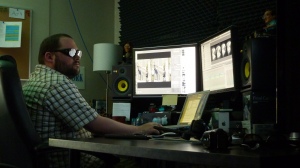Shooting a 3D documentary: Film Factory 3D Indie BS Rig mirror issues
So … we’ve broken the backup mirror we purchased for our Film Factory 3D Indie BS Rig to shoot our first 3D documentary.
This wouldn’t be a huge problem if the stock mirror that came with the rig were up to QC par.
But it isn’t – which is why we were using the backup in the first place.
Here’s the issue: one side of the stock mirror is coated and one side isn’t – the coated side is reflected to the camera that’s mounted on the top of the rig.
This disparity seems to cause a difference in light between the two cameras, to the order of one stop (ie. the upper camera gets about half the amount of light as the horizontal camera).
Our stereographer, Sean White, also found that there’s a slight colour difference between the two cameras, and a mild fogginess to the stock mirror.
We plan to use this rig to shoot the implosion of a condemned sports stadium in HD. And we deal with high-profile broadcasters – we have to deliver high-quality footage (for them and, more importantly, for a worldwide audience).
So Sean grabbed the spare – which we bought in case we break the original one while filming on an industrial site in Salvador, Brazil for the explosive demolition series Blowdown – to see if it gave us more consistent picture.
It did – there’s only 1/3 to 2/3 of a stop difference between the two cameras, the colour is almost matching, and it’s fog-free.
Though none of us are sure why this is the case, we moved to film with the superior mirror (ie. the backup became the starter).
But while Sean was re-screwing it into the rig, it cracked.
The placement process is quite a balancing act – screw the mirror in too loosely (or mess up the gaffer tape), and it threatens to slide out the bottom when you position it at 45 degree angle.
Sean thought he had found the sweet spot for tightening, but he was used to adjusting the stock mirror … the backup shattered under a similar amount of tension (which makes us think the first mirror may contain more plastic, but that’s just a theory).
Needless to say the setback is disappointing.
Sean got in touch with 3D Film Factory. They won’t exchange the stock mirror for one that’s like the backup. But they will sell us another backup at a deep discount.
Granted, this rig is cheaper than most of the other ones out there, so we can’t expect the moon.
But considering how integral a working mirror is to the system, hopefully quality discrepancies and the finicky screw-in process will be rectified in the future.


